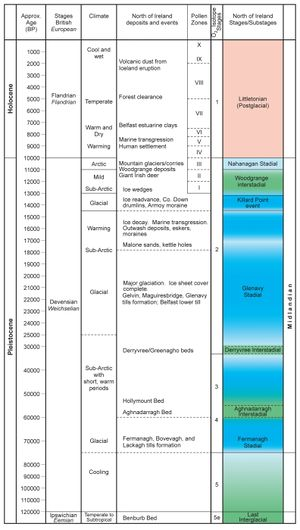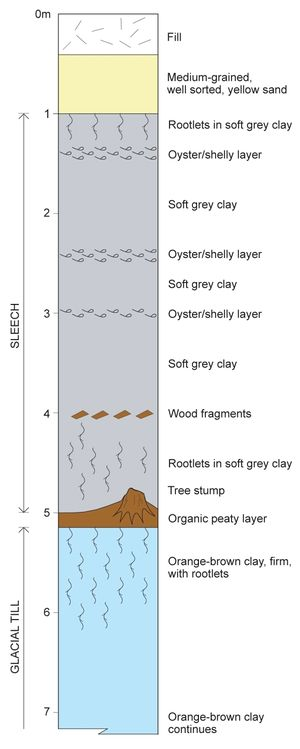Holocene, Northern Ireland
| Mitchell, W I (ed.). 2004. The geology of Northern Ireland-our natural foundation. Geological Survey of Northern Ireland, Belfast. |
R A B Bazley
Holocene



The Holocene Series in Ireland represents the final 10 000 year post-glacial period and is termed the Littletonian Stage (P947951) . After the end of the glacial Nahanagan Stadial (Zone S:III) the vegetation history of Ireland evolved through phases of open-tundra and birch woods (Zone S:IV) to the hazel forests of the early Boreal period (Zone S:V) which were gradually invaded by oak (Quercus) and elm (Ulmus). The establishment of the first high forests only occurred in the succeeding late Boreal period (Zone S:VI) and pollen spectra are dominated by oak and elm and, eventually, pine.
A notable marine transgression (Flandrian Transgression) occurred at about 8500BP in the early part of the late Boreal period (P947951). Rising sea level inundated Strangford Lough, Larne Lough and Lough Foyle and covered thin peat (dated to 9100BP) in the estuaries of the River Lagan and River Bann with grey mud, silt and sand. In the Belfast area this estuarine deposit is known as ‘sleech’ and contains oysters, mussels and gastropods (P947882); (P948047). The combination of very low bearing strength and thickness of up to 17 m presents engineering problems and large buildings are generally founded on a forest of piles to transfer the weight down to stronger material (see Geohazards article). During the transgression maximum, Lough Neagh expanded and diatomite, up to 1 m thick, was deposited in the Bann Valley, south of Portglenone. This white deposit is formed of the siliceous skeletons of some forty species of diatom (alga) which flourished in a Boreal climate 2.5°C warmer than today. The climate also encouraged the formation of white calcareous clay, the Chara Marl, containing freshwater bivalves and gastropods.
In Ireland, the boundary between the S:VI and S:VII zones is recognised by the changing composition of the forests from the warm, dry Boreal climate to a wetter and cooler Atlantic regime. This change is also reflected in the spread of alder, the decline of pine forests and the accumulation of peat in raised bogs. The pine stumps that occur at the base of most peat bogs in Northern Ireland represent this transition. At Sluggan Bog, the first evidence of the influence of Neolithic man on the natural vegetation is found at the end of S:VII.
Around the coast of Northern Ireland the impact of successive phases of marine low-stand and of transgression are evident in the development of post-Glacial raised beaches a few metres above present sea level. There are 8m high bay-head gravel ridges at Cushendun, Co. Antrim. Gravel barriers at Magilligan, Co. Londonderry, although partly concealed by aeolian sand, consist of at least thirty swash-aligned beach ridges that developed some 7000BP [1]. Post-glacial beach levels are also shown by the height of caves at The Gobbins and Cushendun, in Co. Antrim. Extensive areas of windblown coastal sand at Dundrum, Co. Down and at Portstewart Strand and Magilligan, in Co. Londonderry date from the early Atlantic Period (7000–6000BP).
The coincidence between accurate dates for times of narrow tree-ring growth and acid layers in Greenland ice cores suggests that the Irish oaks were reacting to, and thus recording, times of environmental stress. Recent studies of layers of volcanic dust (tephrochronology) in Irish peat have proved the influence of at least nine eruptions within the last 10 000 years, several of which are attributed to the Icelandic volcano Hekla [2]. The Hekla 4 eruption is dated to between 4395 and 4279BP and the possible correlation with narrow tree-rings in 4345BP is compelling evidence for the influence of volcanism in the north Atlantic region on the climate of Ireland at that time.